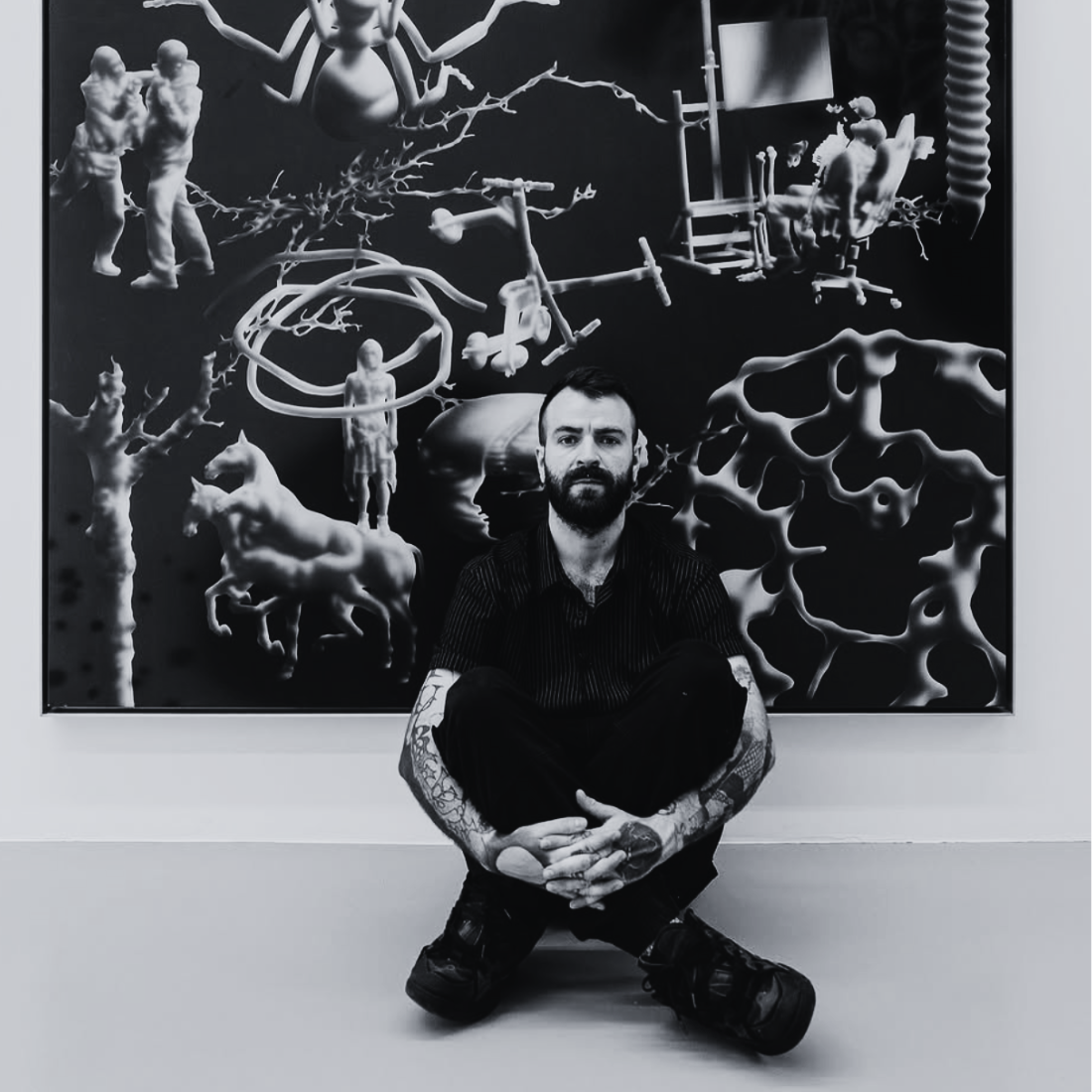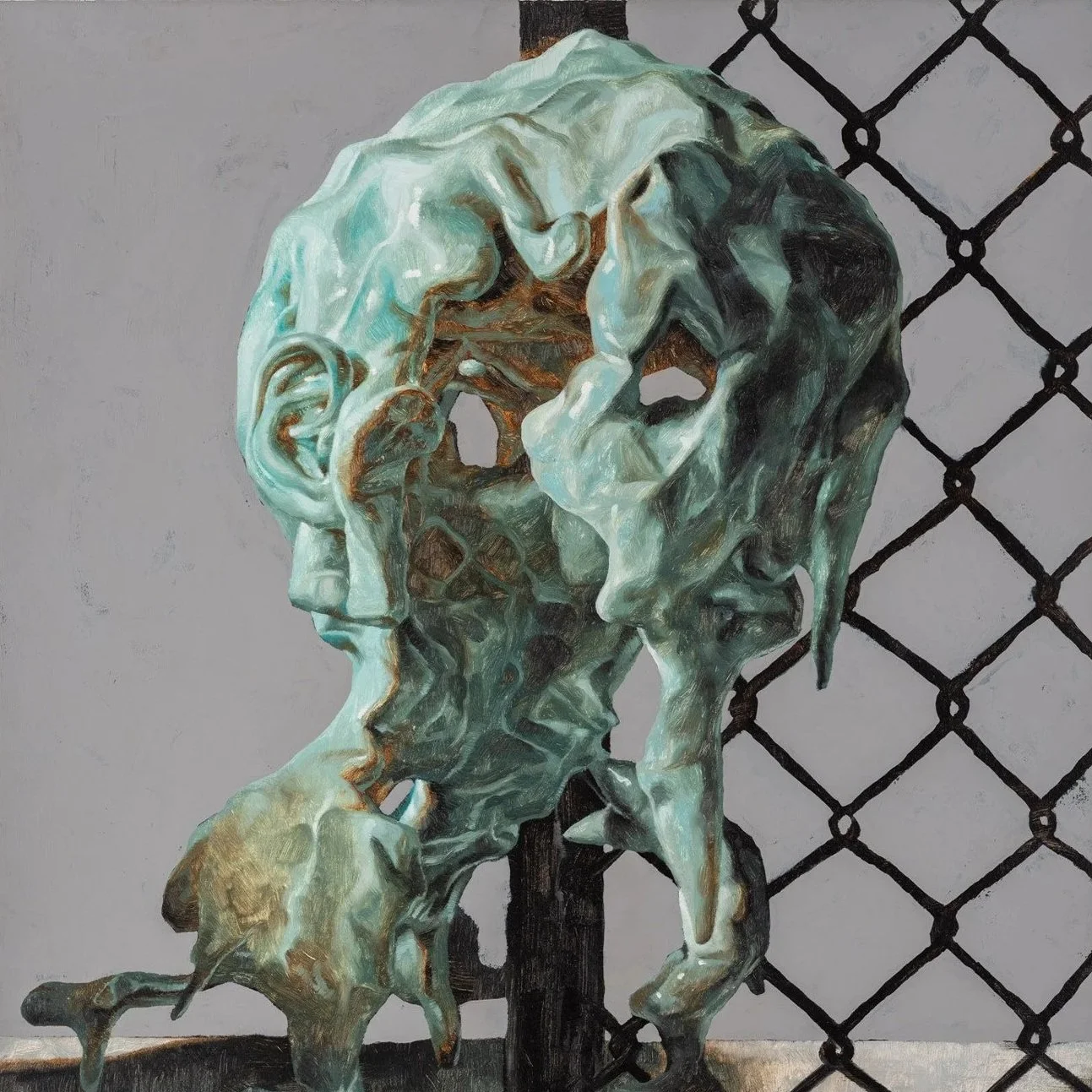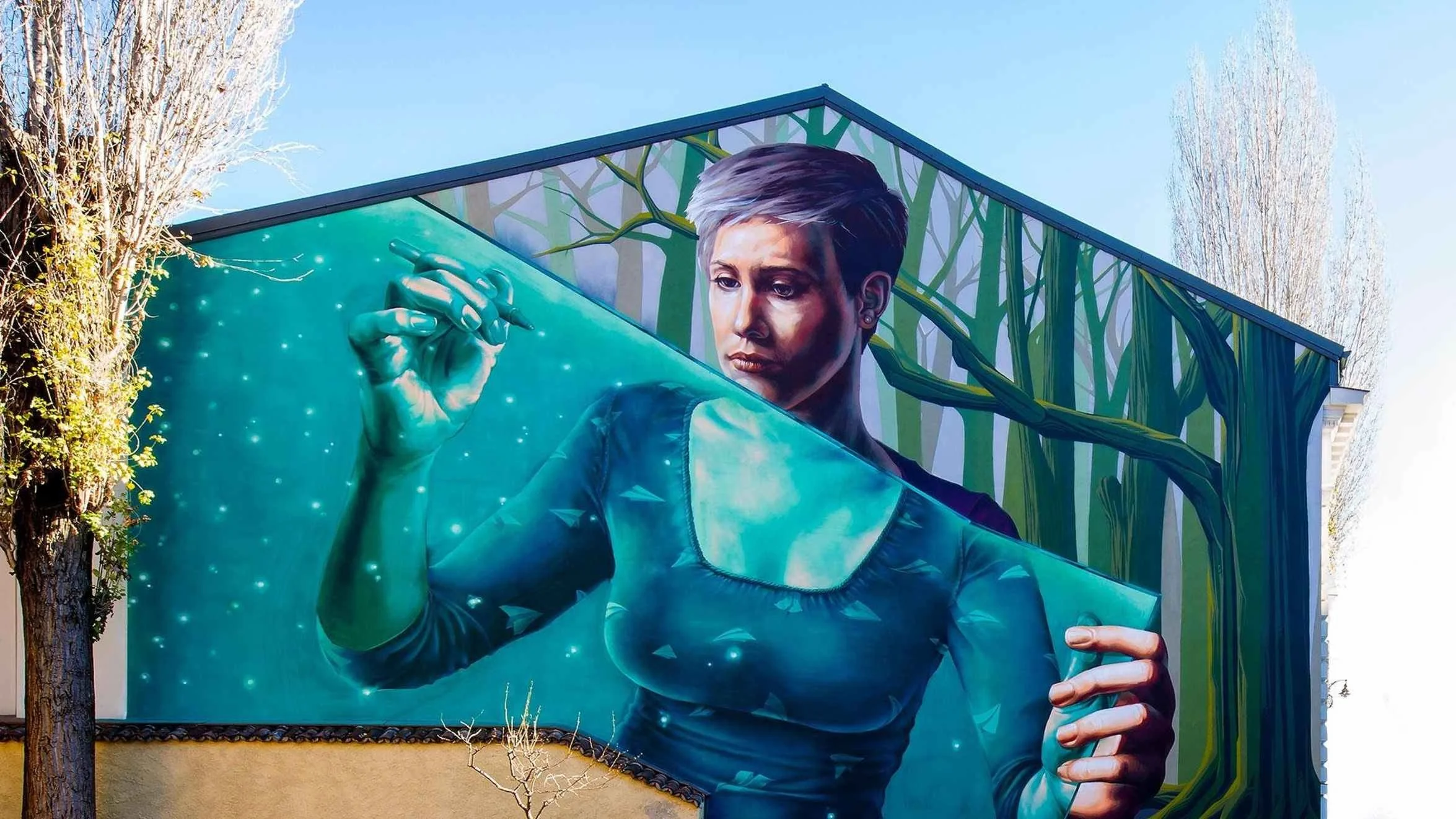Artist Spotlight: Radu Pandele
Radu Pandele has repeatedly been described as one of the key artists in Romania’s new generation of contemporary painters. With a practice rooted in street art that later expanded into digital design, airbrush, and sculpture, Pandele continues to innovate his creative output through an ongoing exploration of new mediums, themes, and techniques.
Image Courtesy: Ars Monitor
Based in Bucharest, Romania, Pandele studied painting at the National University of Arts, where he earned his BFA, before completing two separate MAs in Bucharest and Cluj-Napoca. His academic journey also included an Erasmus+ scholarship at the École Supérieure d’Art de Grenoble—an experience that, in his words, greatly broadened his international outlook on art-making and its systems of circulation.
Detail of: Melted History, 2021, oil on canvas, 100 x 70 cm
Image Courtesy: Ans Azura
Generations of Bucharest residents may recognize one of his earlier mural works, the monumental street portrait near Piața Romană, created as part of the POINT street art initiative—a visible testament to his early years working in public space.
POINT Mural, Eremia Georgescu Street, Bucharest, Romania
Image Courtesy: Sweet Damage Crew
Today, however, Pandele’s focus has turned toward the studio and the canvas. His work combines 3D printing and design, airbrush, and pictorial symmetry to create layered, highly detailed compositions that push the boundaries of painting qua form, while grounding his practice in a deep historical and philosophical framework.
Opera’s Virgil Munteanu was honorably invited to his studio in Bucharest to discuss Radu Pandele’s trajectory, influences, and ambitions.
Entering the wide space on the sixth floor of a building filled with independent galleries and artist studios, one is struck by the density and rhythm of the environment: colored spray cans neatly arranged on the floor, entire corners devoted to 3D-printed models, and walls lined with works by friends and collaborators. It is the working space of an artist in constant motion, yet deeply methodical in his approach.
A separate room is devoted exclusively to the few canvases that have not yet left for exhibitions across Romania and abroad—each one a window into a highly personal, precise, and evolving visual world.
Virgil Munteanu: Your style is unmistakable—people can recognize one of your paintings almost instantly. This is something many artists aspire to, no matter how well-known they are. How did this distinctive visual language come to be? What are some of the key influences behind your practice?
Radu Pandele: There are quite a few, but Hieronymus Bosch always comes to mind first. Conceptually and philosophically, Emil Cioran has also been very present in my thinking and in my work. I admire him deeply—not only as a writer but as a human being. I collect manuscripts and small objects related to him; in fact, I own the first page of one of his manuscripts. Cioran’s view of life as absurd yet worth confronting is something I strongly relate to. It helps me not only as an artist but as a person.
Space Laboratory
Airbrushed acrylic ink on canvas
150/100 cm
Executed in 2023
Image Courtesy: Radu Pandele
VM: Aesthetically, many of your works include this liquid, almost shimmering symmetry that spreads across the surface of the canvas. What is this element, exactly?
RP: It’s a type of dripping — almost like condensation on glass. I like to imagine that I’m looking at the subject through a window, and some liquid is slowly flowing over it. It’s become an important part of my visual vocabulary. I’m trying to build a method of painting where the work can be looked at as if it were lived — as if the viewer were inside that visual world. The liquid element is a trace of that lived-ness.
VM: This darker work here [unpictured] caught my attention as well. Can you tell me more about it?
RP: It’s a dialogue with one of Ion Țuculescu’s last paintings, Testament. I’ve always been fascinated by the story of him in his hospital bed, insisting that he be released so he could complete what he called his “final will” on canvas. That image stayed with me.
Technically, it’s a representative work—just like the original. People sometimes assume it’s abstract, but I’m too young to paint Abstract. (laughs) I think abstraction comes with time, with experience — Gerhard Richter, for example, only fully turned to abstraction later in life. I feel that right now I still need to construct my own artistic universe before I deliver such “ultimate” statements as Abstract art often provides.
VM: Tell me a bit about your process—how these works come into being.
RP: I usually start with a 3D model that I design digitally. It allows me to control light, form, and composition before painting. Then I transfer that model to canvas, using acrylics, airbrush, and spray. It’s a combination of precision and intuition. What matters most to me is that a work must be complete in three ways: it has to be aesthetically complete, conceptually valid, and it must be something that someone could live with for the rest of their life. Only then do I consider it a truly finished work.
VM: And what about the life of the artist—how do you see your role today?
RP: I think an artist’s life should aim toward completeness as well. For me, that means aligning thought, action, and words. It’s not just about making good paintings; it’s about striving to be a complete man. In my artistic universe, I’m constantly trying to dissect and question reality—through art, but also through daily life.
VM: Looking forward, what directions or projects are you most interested in pursuing?
RP: I’m very drawn to large-scale installations. I want to expand the universe of my paintings into space, into something immersive. But I also want my work to remain grounded philosophically—to keep asking questions about what it means to live and experience reality. One of my guiding thoughts right now is: how can my artworks be truly lived?
And yes, we’re still a bit “in the back of Europe,” as I like to say, but I do think things are improving. Gallerists, fairs, collectors—they’re becoming more rigurous, more aware. We’re heading in the right direction. My biggest goal is not to live and die as “the best in the local village.” I want to grow beyond that, to build an international dialogue around my work.
Radu Pandele’s trajectory—from his early murals on Bucharest walls to his increasingly complex studio practice and international exhibitions —embodies the evolution of a new generation of Romanian artists navigating between tradition, technology, and philosophy. His work stands at the crossroads of image and idea, gesture and concept, surface and system. Through his synthesis of technique and inquiry, Pandele’s practice asks not only what painting can be, but how it can be lived.
Opera is proud to highlight his vision and looks forward to following his journey as one of the most compelling contemporary voices emerging from Romania today.
To learn more about Radu Pandele’s work or inquire about available pieces, please contact Opera Art Advisory & Collective at info@operaadvisory.com or visit our website.
We are Opera. Follow the Journey. Join the Collective.




